I do not want to give you the impression I have the sole little piece of gwondanaland struggling to survive. A lot of direct descendants of the original Cretaceous forest still struggle on today out in wild. Some are ideally acclimatized for the harsh climates of southern Africa and Australia. Others are tropical forest specialists. Some are being pampered in special collections, like these cycads in Adelaide's Botanical Gardens.
Monday, September 17, 2007
Sunday, September 09, 2007
The green drought!
It has been a long time between post. I seemed that the rain had come and things where returning to their normal seasonal cycle.
However I have just noticed that the new fern was looking decidedly dry. Maybe it was true, the myth of a green drought was coming true. I firmly believe the culprit was actually a few days of unseasonal dry north winds, but I am returning to the shower bucket method and watering the head of the stem as new shoots emerge just to be on the safe side.
Thursday, April 12, 2007
The palm "terrace" takes shape

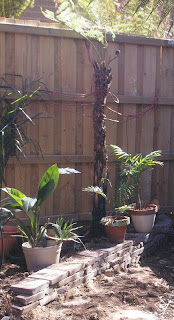
The new fern has prompted me to remove the remaining bamboo (a hard task by the way) and start the basis for the palms end of my cretaceous garden. I know "Palm Terrace" is a lofty title but it is a fraction elavated. I plan to leave the center hollow so I can rotate potted palms from indoors. The soil is hopeless clay but in the process of digging out the babmoob runns it has had a good digging over. I plan just to add about 30cm of leaf litter rather than a top soil to gove it a rainforest floor feel. The fern looks quiet happy after its transplant, despite the continued warm (and dry weather)
Saturday, April 07, 2007
something new

This is the first time I have noticed a spiders web in my cretaceous garden. It might indicate that the garden is drying out, normally I associate spider webs with dry, very low humidity, places. Whilst i have seen plenty of spiders around, red backs, white tails, and huntsman, but i suspect this is an orb spider web (the nicely circular section on the center is very characteristic). You never know it may well be a close relative of the spiders in space that perished when the columbia came apart on renetry. Those golden orb spider came from around this way.
Looking around the web, internet that is, I still can't find any evidence to support my suspicion that spiders webs mean the garden is drying out, but here is great page a spider myths
Thursday, April 05, 2007
saving a tree fern

The tree ferns of melbourne are having a hard time, even my own ones. They seem to have been dropping their outer fronds, dry and brown at a great rate. I suspect it is just a sign of drought stress, a lot consider that they are dying. Anyway to cut a long story short I have me offered a couple if i think I can save them.

Well I may as well have a go, my first patient is a very thin fern and I can not figure out exactly which species it is, my best guess is Dicksonia fibrosa. So rather that just do the old saw it off and stick it back in the ground, whichwork well enough for Dicksonia antarctica, I decided to get a significant part of the root mat, which were only growing across the surface.
 I also trimmed off all the fronds other that the new sprouts. With a little close supervision to make sure the roots don't dry out I expect it will thrive in my little bit of gwondanaland.
I also trimmed off all the fronds other that the new sprouts. With a little close supervision to make sure the roots don't dry out I expect it will thrive in my little bit of gwondanaland.The final problem remains where to plant it?
Sunday, April 01, 2007
Something for April Fool's Day
Its official Melbourne's water storages are currently 32.1% full (as at 1/4/2007). Despite the rain the overall storage is still falling. Some dams are rising by other failing a lot. Should this be a problem? The common explanation seems to be that the soil is taking up all the moisture and keeping run-off into the dams minimum. Another explaination is water may to be being shunted around.
The aprils fool day message bit is that this should have triggered level4 restrictions. However the Victorian government, or more specifically those politicians based in Melbourne,has gone a bot weak at the knees and changed the rules. So now we are have a claytons change to the rules when a real change to the rules could have had a bit of a voter backlash. So now we have water restriction level 3a.
The aprils fool day message bit is that this should have triggered level4 restrictions. However the Victorian government, or more specifically those politicians based in Melbourne,has gone a bot weak at the knees and changed the rules. So now we are have a claytons change to the rules when a real change to the rules could have had a bit of a voter backlash. So now we have water restriction level 3a.
Saturday, March 31, 2007
Happy Plants
Yesterday's rain has given way to sunshine and a glorious march day, perfect to take some photos for the photofriday challenge growth. The plants just seem to be happy :)


Friday, March 30, 2007
rain


Well decent rain is falling, and we may even get close to our normal march average. With the long term predictions still suggestion better than average rains through autum. If you are interested the Australian Bureau of Meterology has a great area on their website to graph and compare a number of key climate measures.
sorry for the hiatus

I've been away and back and away a lot, so my humble cretaceous garden has had to fend for itself. It has done so admirably, compared with other more conventional plantings elsewhere in my garden. So I think there may be a myth, ormoral here, perhaps cretaceous plants thrive best by neglect! (and tropical weather, even without the rain).
Monday, February 19, 2007
What the?

The bamboo, that I still intend to remove, is one plant flourishing, But why the heck is this new miniature growth appearing on most spikes. Is it the mythical 50, or was that 500 year flowering. The myth says all the bamboo dies (now that would be a good thing) after that gregarious flowering event but famine, dark despair and untold hardship descends on the land.
Sunday, February 18, 2007
the rule of 10
I've been away and my garden missed any watering for almost two weeks during hot dry weather, with the remote possibly of a local thunderstorm/downpour in there maybe. Things were looking wilted but survived, infact the cretaceous part has faired better than most other parts of the garden (most probably because it is protected from the scorching north winds). One water and things seem to have sprung back to life.
So "How long to water?" is probably the big question around here at the momement. My mother's suggestion is possibly the best I have heard
How much water the plants get depends mainly on your water pressure and which nozzle setting you have on your triger hose (under current water restrictions you can only water, at the designated times, using a hose fitted with a trigger nozzle, which instantly cuts off the water when you release it). However it is easy to work out the flow, just place the hose into a standard plastic bucket (most of which have volume marks on the side) count to 10 and see how much water is there. With a bit of calibration you might be happier count to 5,7 or even 15).
How much water your garden needs, is a more complex issue and is sure to be the topic of posts to come.
So "How long to water?" is probably the big question around here at the momement. My mother's suggestion is possibly the best I have heard
Count to ten (1..2..3..4..5..6..7..8..9..10) slowly as you water important shrubs
...my mum
How much water the plants get depends mainly on your water pressure and which nozzle setting you have on your triger hose (under current water restrictions you can only water, at the designated times, using a hose fitted with a trigger nozzle, which instantly cuts off the water when you release it). However it is easy to work out the flow, just place the hose into a standard plastic bucket (most of which have volume marks on the side) count to 10 and see how much water is there. With a bit of calibration you might be happier count to 5,7 or even 15).
How much water your garden needs, is a more complex issue and is sure to be the topic of posts to come.
Tuesday, February 06, 2007
The bucket brigade, a month on.
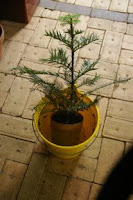
Melbournians, including me, have embraced using plastic buckets as a really easy way to save water (eg. first flow in the shower). In fact their has been a massive 24% reduction in water usage for january 2007 (compared with the same time last year) in a year when January has been significnatly hotter and drier than average. So water restrictions are working and most people are acting responsibly. We even have a website to monitor weekly water usage now.
Well done folks.
Monday, February 05, 2007
Drip Watering #4

 The Melbourne City council have come up with a great way to water their significant trees. All around the center of Melbourne at the moment you will see the red and white traffic barriers babysitting a big tree. These barriers are designed to be filled with water to make them heavy, in their normal traffic`hjazard management duties, but with the simple addition of a drip hose they can become a personalised tree watering system that the council can refill with recycled water periodically.
The Melbourne City council have come up with a great way to water their significant trees. All around the center of Melbourne at the moment you will see the red and white traffic barriers babysitting a big tree. These barriers are designed to be filled with water to make them heavy, in their normal traffic`hjazard management duties, but with the simple addition of a drip hose they can become a personalised tree watering system that the council can refill with recycled water periodically.
Friday, February 02, 2007
Nocturnal visitors

This guy, a small bushtail possum Trichosurus vulpecula, is not such a welcome quest. His relatives devastate fruit frees and prize plants around here this time of year and seem to be flourishing in tree lined street of Melbourne. Whilst they are officially protected in Victoria, most locals consider them pests. Despite looking cuddly and docile these small marsupials have sharp teeth and claws as many dogs and cats soon find out.
This is the species of possum that has caused such environmental destruction, when they were introduced to New Zealand.
my other (token) conifer
At the moment they only other conifer (other than the wollemi pine),is a very low growing juniper. It was planted long ago, vaguely I remember it having a name like carpet juniper, and it looks a little like a Juniperus squamata but thats supposed to be fast growing and this one is definitely not that!

I did have two other conifers, pencil pines, but they were growing so fast and tall I had to move them well away from the house. They were definitely unsuited to my restricted space. Now I just have to dream of getting a more slow growing King Billy, Celery top or Huan Pine to replace them.

I did have two other conifers, pencil pines, but they were growing so fast and tall I had to move them well away from the house. They were definitely unsuited to my restricted space. Now I just have to dream of getting a more slow growing King Billy, Celery top or Huan Pine to replace them.
Thursday, February 01, 2007
An interesting (re)discovery

Today I came across some old sketches of my original ideas for the cretaceous garden. The first was perhaps a little ambitious, with a water feature and mini pier from the carport. However on the back of this sketch was an interesting hand written list-
suitable plants with cretaceous ancestors
- ferns
- moss
- cycads
- laurel (eg sassafras)
- cypress (low growing)
- deciduous beech
- ginkgo
- bamboo ??
The fact that I had included bamboo suggest that I had not researched this list well, if at all. Grasses, of which bamboo is one, didn't really evolve until until after the cretaceous (but more about bamboo later) I suspect it is on the list because it was already there in the garden.
I also has a second list of look-alike cretaceous plants
- broad leaf cover (eg aspidistra)
- pin cushion plant
Looking back that was a pretty good list to start, and matches what has flourished, I'm giving myself 7 out of 10 for plant selection (now is that a B minus or a C plus on a standardized marking system?)


My second design is much closer to what I have created it has a dry creek bed of rocks instead of a pond. I left out the stepping stone and have a mini island instead.
You might like to see what the area looked like before it became cretaceous.
Wednesday, January 31, 2007
what's happening to ENSO?
Like many weather watchers the Australian Bureau of Meterology has its own El Niño watch page on their website, and today it has some good news
In simple terms that means more rain and maybe even the end to the current drought conditions and it will start happening soon. Assuming it does I will confidently predict now that this will re-ignite a lot of discussion about whether the drought conditions in south-eastern Australia are part of a normal el-nino cycle or that they are evidence of mankind induced climate change.
 If you want to monitor the changes in el niño, also known as the southern oscillation (or ENSO), the Noaa/TAO website is a great place to start.
If you want to monitor the changes in el niño, also known as the southern oscillation (or ENSO), the Noaa/TAO website is a great place to start.
"Summary: El Niño continues to weaken
... it bodes well for a switch towards average or wetter than average conditions across eastern Australia sometime in the late summer or autumn."
CURRENT STATUS as at 31st January 2007
In simple terms that means more rain and maybe even the end to the current drought conditions and it will start happening soon. Assuming it does I will confidently predict now that this will re-ignite a lot of discussion about whether the drought conditions in south-eastern Australia are part of a normal el-nino cycle or that they are evidence of mankind induced climate change.
 If you want to monitor the changes in el niño, also known as the southern oscillation (or ENSO), the Noaa/TAO website is a great place to start.
If you want to monitor the changes in el niño, also known as the southern oscillation (or ENSO), the Noaa/TAO website is a great place to start.
New growth update
Tuesday, January 30, 2007
meet the cycads

Cycads (pronouces sigh-kads) are an order of plants that flourished during the Mesozoic Era. They have large pinnately compound leaves (fronds) that superficially resemble palms and some ferns. However these plants have a markedly different strategy for reproduction, since they developed before insects had evolved on land. They are dioecious, which means there are seperate male and female plant, and have cones rather than flowers.
 Cycads are very common in the Australian fossil record They are generally very hardy plants and are still growing in many parts of the world. Most widely in South Africa, South America, the Pacific and Australia (as a relict of their Gwondanaland floral heritage). They are widely believed to have been a significant food source for dinosaurs. The seeds of many cycads are poisonous, containg BMMA, a neurotoxin which results from the cycad's roots close relationship with blue green algae that also helps these plants fixed nitrogen into the soil. In the pioneering days of european settlement in Australia, cycads where "harvested" as a rich source of starch, not for eating but as a laundring aid.
Cycads are very common in the Australian fossil record They are generally very hardy plants and are still growing in many parts of the world. Most widely in South Africa, South America, the Pacific and Australia (as a relict of their Gwondanaland floral heritage). They are widely believed to have been a significant food source for dinosaurs. The seeds of many cycads are poisonous, containg BMMA, a neurotoxin which results from the cycad's roots close relationship with blue green algae that also helps these plants fixed nitrogen into the soil. In the pioneering days of european settlement in Australia, cycads where "harvested" as a rich source of starch, not for eating but as a laundring aid. I have several sago palms, cycas revoluta, a japanese variety, which is probably the most popular cycad for cultivation. They where starting to look very unhealthy in the heat, the frond turning yellow and dropping down. Then just as I was worrying, two of the larger plants sent up new fronds. I am not sure if it was the heat, or the smoke hazy that triggered this change, I remember hearing that cycads are a type of plant that flourish after a fire
I have several sago palms, cycas revoluta, a japanese variety, which is probably the most popular cycad for cultivation. They where starting to look very unhealthy in the heat, the frond turning yellow and dropping down. Then just as I was worrying, two of the larger plants sent up new fronds. I am not sure if it was the heat, or the smoke hazy that triggered this change, I remember hearing that cycads are a type of plant that flourish after a fire
Thursday, January 25, 2007
the bird nest fern

The birds nest fern,Asplenium australasicum, is a epihyte fern which is common in the tropical rainforests of northern australia and nearby pacific islands. It has long simple radianting fronds that are an attractive light green. Like the soft tree fern its inverted umbrella shape of fronds helps collect and channelwater and leaf matter down onto its growing center.
Of all the plants in my garden it is this fern that likes the highest humidty. I expect this to be the best indicator plant of creataceous-like condition in my garden. However since it doesn't have a true ground penetrating root system it does not really give me a representative view of the saturation/driness of the soil.
Tuesday, January 23, 2007
more yellow spots

Just noticed more yellow spotting, this time on a small cycad, is this a sign of drought stress, air pollution or another problem from the hail at christmas. For now I'll assume it is hail damage and the plant will recover.
Sunday, January 21, 2007
Where did the cretaceous weather come from?

The anwser is simple it came dowm from the tropics. Looking at the lastest satellite image, which I got from the Bureau of Meterology's satellite page. You can see the big band of cloud coming down the east coast of Australia. A tropical Low (low pressure area) in Northern Australia had connected with low coming acrosss the Great Australian Bight and it just sucked all the hot moist air south (where it is needed)
Where did the water go?

The water levels of Melbourne's dams are now published daily, and a surprising number of people are well informed on the levels. Today "The Sunday Age" had a story about the bit dry (it has actually rained for two days now) and mentioned that the dam levels fell 0.1%, in a sidebar, strangely the article only indicated 8mm of rain in the past 24 hours and the rainfall section back a bit only showed 1.5mm. I can tell you it rained more than that. Checking on the net I could see that the average around melbourne was 24mm and some place over 40mm in some places (mainly the areas were our water catchments and dams are). This which is closer to what I expected.
So what is going on here. Well I found one likely cause, the news paper story is probably not basing its discussion on up to date data. It appears to be based on Melbourne Water's website (which at the time of writing had not been updated for the recent rains.)
This melbourne water conserve water website is interesting, it gives all the dam levels and also mention that melbournes consupmtion (on average, and that means without water restrictions is 500 giga litres, which is 500,000 megalitres). The full capacity of our dams from this source is 1,773,000 megalitres which is about three and a half years supply. We are now down to 66,577 megalitres and that thens leave close enough to 1.32 years of unrestricted use. Sorry haven't managed to track down the about of water that is expected to be saved by the restrictions.
The inaccuracy of the newspaper report asided, does all the panic about water and water restrictions really seem like we are despeate and about to run out of water? Over a years worth does seem ok to me when much of northern victorian has virtually none left, but to me it is even harded to justify expensive TV adds to dob in water wasters.
Or is the urgency perhaps more to do with political spin!
Saturday, January 20, 2007
Some excitement
Friday, January 19, 2007
soaking rains, at last

Well overnight and this morning we have had some decent soaking rain. Perhaps not enough to fill the dams or put out the bushfires, but the plants certainly liked it (and so have the birds). It is still hot and humid, I would imagine this is perfect cretaceous weather.
Thursday, January 18, 2007
cast in iron
The Aspidistra (Aspidistra elatior) better know as the cast iron plant was a very popular indoor foliage plant in the Victorian era. To the best of my knowledge it is not related to any Cretaceous plant species, it just looks a lot like some of them. It also has the massive advantage that it is thriving in the dry shady areas under the tree ferns.
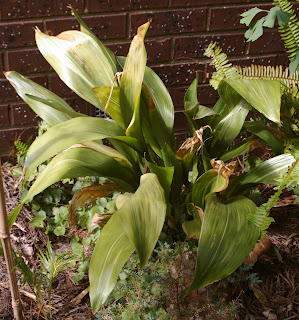

They are angiosperms (flowering plants), but I haven't seen any flowers, apparently they occur at soil level and are only pollinated by terrestrial Amphipods little shrimp like creatures, (such as sand fleas, and other little bitty varmites). The angiosperms developed late in the jurrasic and spread extensively in the late cretaceous, particularly in the northern continent of laurasia.


They are angiosperms (flowering plants), but I haven't seen any flowers, apparently they occur at soil level and are only pollinated by terrestrial Amphipods little shrimp like creatures, (such as sand fleas, and other little bitty varmites). The angiosperms developed late in the jurrasic and spread extensively in the late cretaceous, particularly in the northern continent of laurasia.
Wednesday, January 17, 2007
Grey Water : Marque II

Whilst at the hardware I bought 15meters of 13mm black poly tubing (for my drip irrigation work) so I thought I'd try out syphoning out the gray water. Our washed empties into a special drain on the laundry sink, so it is easy to lift the washing machine discharge tube out of its drain and direct the discard into the sink. The theory was that I could them syphon the water from there.
BUT there were problems. Firstly it is important that the water level does not get higher that the washing machine's discard tube, or the water pumped out will backwash syhpon back into the machine (I learnt this the hard way). Second starting the syphon is not so easy with the 13mm poly pipe. Using the well tried method, of making three or so loops and letting all the air bubbles out then clamping you thumb over the end and lift the loops out and then let off your thumb, was not so easy with the tubing which wanted to kink and fold rather make the tight loops I needed to get into the sink. The tubing is light and wants to float to the surface, and loose suction, so I need a brick to hold it down.
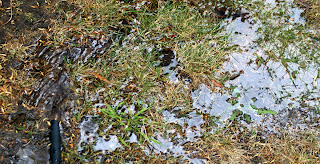
With patience I got the syphon going and it worked well. Still it was a lot or mucking around you probably would not want to have to do that routinely.
Waiting for the rain
 So the heat (over 40 C) continues, the serious bushfires continue and the weather bureau is forecasting "chance" of rain and "risk" of thunderstorms. I think that is just bureau spin for a few drops of rain, which unfortunately evaporates soon after landing. The drought drags on.
So the heat (over 40 C) continues, the serious bushfires continue and the weather bureau is forecasting "chance" of rain and "risk" of thunderstorms. I think that is just bureau spin for a few drops of rain, which unfortunately evaporates soon after landing. The drought drags on.Without doubt the best way to deep water your garden is via natural heavy rain. However the continued dry conditions can cause soils to become hydrophobic (literally it means afraid of the water) which in physical terms it means that the soil gets a skin that repels water. How soils are affected depends on the soil type. In Melbourne the most sandy soils will quite quickly become hydrophobic, the surface affected with waxes from plants, air fall of hydrocarbons and oily polutants and possibly some natural near surface fungal and baterial actions. Melbourne more clay soils (>30% clay) areas will also be affect but only after the clay has started to dry out. First it becomes very hard, and then surface with start get powdery and large shrinkage cracks will open up. This occurs because the clays are loosing their formation water (water that makes up part of clays crystal structure). The fine powder particles of this dehydrated clay are then on the look out for water and will stick to water droplets rather than staying attached to other clay particles. The clay coated droplets soon coagulate and form a mat that forces any further water to run-off.(This drying of clays has the potentially to damage structures, like your house, via subsidence but this will need to be a separate post)
The best way to fix this in the long term is to add lots of organic matter to the soil to change its structure, and add a surface mulch.(when mulches are too thick and allowed to dry out they can apparently themselves become hydrophobic)
In the short term there is a group of materials called Surfactants (or wetting agents). They work by reducing surface tension of water, and are generally complex organic compounds which have one end which is water loving (hydrophilic) and the other water averse(hydrophobic), they work by acting as a joining agent. Soap and detergents are good surfactants, so using soapy grey water on areas that seem to be becoming hydrophobic has some merit as a good way to pre-wet the surface.(but the affect may only last a few hours).
Tuesday, January 16, 2007
Introducing the plants
How rude of me I have been rambling on mainly about watering and I forgot to introduce you to some of the important plants in my 100 million year old garden. The plants themselves are of course not that old, most are less than 10 years old. They are just the same or very similar species to those that existed back in cretaceous times.
 Having a look at my plants I see that my Ginkgo Bilboa (Maiden Hair tree) has some spotting on the leaves. Not sure if this is drought stress or the result of hail at christmas. You can see a younger and happier leaf, on the same tree, in my photo blog, wandering in the light.
Having a look at my plants I see that my Ginkgo Bilboa (Maiden Hair tree) has some spotting on the leaves. Not sure if this is drought stress or the result of hail at christmas. You can see a younger and happier leaf, on the same tree, in my photo blog, wandering in the light.
The gingko is not only a fascinating plant, it is the source of a powerful phytochemicals (commercially produced GBE or Ginkgo Bilboa Extract, is normally standardized to 24% ginkgo flavone glycosides and 6% terpene lactones) that has many claiming it as a wonder drug but it cannot be safely mixed with a number of common prescription medicines, including asprin. You can also dry the leaves yourself and make a great "pick me up" tea. Another amazing fact I found out about gingko is there are four special gingko trees that survived the 1945 atomic bomb at Hiroshima in Japan, and are still alive today.
Stay tune because I'll write a lot about my gingko
 Having a look at my plants I see that my Ginkgo Bilboa (Maiden Hair tree) has some spotting on the leaves. Not sure if this is drought stress or the result of hail at christmas. You can see a younger and happier leaf, on the same tree, in my photo blog, wandering in the light.
Having a look at my plants I see that my Ginkgo Bilboa (Maiden Hair tree) has some spotting on the leaves. Not sure if this is drought stress or the result of hail at christmas. You can see a younger and happier leaf, on the same tree, in my photo blog, wandering in the light.The gingko is not only a fascinating plant, it is the source of a powerful phytochemicals (commercially produced GBE or Ginkgo Bilboa Extract, is normally standardized to 24% ginkgo flavone glycosides and 6% terpene lactones) that has many claiming it as a wonder drug but it cannot be safely mixed with a number of common prescription medicines, including asprin. You can also dry the leaves yourself and make a great "pick me up" tea. Another amazing fact I found out about gingko is there are four special gingko trees that survived the 1945 atomic bomb at Hiroshima in Japan, and are still alive today.
Stay tune because I'll write a lot about my gingko
Monday, January 15, 2007
Deep Watering : Method #3
Another good way to water deep and save water is to use a dripper system, and these are allowed under level 3 water restrictions. The best ones are pressurized and have the special dripper buried deep in the soil (20-30cm). They really require professional installation, and are therefore expensive. Right now in Melbourne there is also apparently a long waiting queue to get then installed.

The question I am interested in for now is is there a simple alternative (that works at low/normal pressure). Better still is there a way that I can just replace th heads on my existing "black pipe" sprinkler system. Sounds like a good excuse to visit Bunnings (a big hardware, home improvement and just about everything chain). Well the good news is there are several ways to do this, the bad news (for me) was most where sold out, only the most expensive fittings were left. So I ended up getting buying from the pope range rather than the nylex gardena range (which my system was mainly built from). I also got some repair plugs to temporarily seal some of the riser locations (I didn't want to remove them). Using the variable tricklers (pope Veri-Flow) has has the advantage that I can adjust the flow if individual. Now all I have to do is wait till my watering night, when I can test it out.


The question I am interested in for now is is there a simple alternative (that works at low/normal pressure). Better still is there a way that I can just replace th heads on my existing "black pipe" sprinkler system. Sounds like a good excuse to visit Bunnings (a big hardware, home improvement and just about everything chain). Well the good news is there are several ways to do this, the bad news (for me) was most where sold out, only the most expensive fittings were left. So I ended up getting buying from the pope range rather than the nylex gardena range (which my system was mainly built from). I also got some repair plugs to temporarily seal some of the riser locations (I didn't want to remove them). Using the variable tricklers (pope Veri-Flow) has has the advantage that I can adjust the flow if individual. Now all I have to do is wait till my watering night, when I can test it out.

Sunday, January 14, 2007
Deep Watering : Method #2

Our local Council, have long had the practice of adding about 30cm of flexiable tubing when they plant new street trees. They then come around every month of so on the trees first two summers and fill the pipe with water.
So this second method involves adding a pipe or other channel way to let you deliver water deep below the new developing roots when you do the planting. The same pipe can come in handy during dry spells. However trying to add pipe below existing plant may do more damage than good. If you buy plants in tubes (they are very economic to buy that way) a great thing to do is bury the tube (unfortunatey the tube pots are seldom longer than 10cm) right beside the plant as you are planting it, you can then fill this tube with water as the plant develops.
Deep Watering : Method #1

Deep watering can be very easy. For an area that yous don't want to dig over (eg around established shrubs) you can just get a garden stake, crowbar, or any strong and pointy and hammer it into the ground say 20 to 30cms around those things you wan to water deep. You can leave the whole open or put in some satur-aid or compost. Just make sure it fills up.
Some councils around melbourne are using an "air lance" (a compressed air operated probe, to do a similar job around established trees
Saturday, January 13, 2007
Checking the "soil"
I might have been joking before when I said I didn't know how to water. Where when and how you water depends mainly on your soil. In fact, I often watch Gardening Australia on the ABC and remember a great experiment performed by Jerry Coleby-Williams , where he oven dried three soil types and then monitored how much water they drew from a bucket of water. Read their fact sheet for more information.
 So I went and had a look at my soil. Well for starters it isn't soil at all; its just muddy/silty clay with a little organic matter of the top. I figure when I was building up the garden that there was precious little cultivation back in the Cretaceous, so I didn't dig over the garden or add compost to the mud. I do know the soils where often waterlogged back then and problably not like the organic & humic rich profiles we call soil today. But I assume there was plenty of rotting vegitation on the ground, so I just add dead leaves to the surface from time to time. Even with my watering last Tuesday and a few sprinkles of rain since, it is clear my subsoil is powdery dry. The organic matter is however slightly damp. Opps that means I'll be encouraging the plant root to stay near the surface where they are much more likely to dry out. Not what I want at all.
So I went and had a look at my soil. Well for starters it isn't soil at all; its just muddy/silty clay with a little organic matter of the top. I figure when I was building up the garden that there was precious little cultivation back in the Cretaceous, so I didn't dig over the garden or add compost to the mud. I do know the soils where often waterlogged back then and problably not like the organic & humic rich profiles we call soil today. But I assume there was plenty of rotting vegitation on the ground, so I just add dead leaves to the surface from time to time. Even with my watering last Tuesday and a few sprinkles of rain since, it is clear my subsoil is powdery dry. The organic matter is however slightly damp. Opps that means I'll be encouraging the plant root to stay near the surface where they are much more likely to dry out. Not what I want at all.
[WATERING MYTH #1:I think a lot of people will discover this the hard way, after "doing the right thing" and mulching their gardens to "drought proof" them, only to find many prize older plants still curl up and die, because their older and deeper roots are not getting any water. All the water is in the satur-aid and mulch at the surface, only the shallow roots will benefit]
Some deeper watering is required, But how?
 So I went and had a look at my soil. Well for starters it isn't soil at all; its just muddy/silty clay with a little organic matter of the top. I figure when I was building up the garden that there was precious little cultivation back in the Cretaceous, so I didn't dig over the garden or add compost to the mud. I do know the soils where often waterlogged back then and problably not like the organic & humic rich profiles we call soil today. But I assume there was plenty of rotting vegitation on the ground, so I just add dead leaves to the surface from time to time. Even with my watering last Tuesday and a few sprinkles of rain since, it is clear my subsoil is powdery dry. The organic matter is however slightly damp. Opps that means I'll be encouraging the plant root to stay near the surface where they are much more likely to dry out. Not what I want at all.
So I went and had a look at my soil. Well for starters it isn't soil at all; its just muddy/silty clay with a little organic matter of the top. I figure when I was building up the garden that there was precious little cultivation back in the Cretaceous, so I didn't dig over the garden or add compost to the mud. I do know the soils where often waterlogged back then and problably not like the organic & humic rich profiles we call soil today. But I assume there was plenty of rotting vegitation on the ground, so I just add dead leaves to the surface from time to time. Even with my watering last Tuesday and a few sprinkles of rain since, it is clear my subsoil is powdery dry. The organic matter is however slightly damp. Opps that means I'll be encouraging the plant root to stay near the surface where they are much more likely to dry out. Not what I want at all. [WATERING MYTH #1:I think a lot of people will discover this the hard way, after "doing the right thing" and mulching their gardens to "drought proof" them, only to find many prize older plants still curl up and die, because their older and deeper roots are not getting any water. All the water is in the satur-aid and mulch at the surface, only the shallow roots will benefit]
Some deeper watering is required, But how?
Friday, January 12, 2007
BL**D!3 B@MB**

This area is to be an extension into the late creataceous, mainly palms, and also where I plan to put a rainwater tank. I needed to clear the area for the constrution of a new fence. Previously the area was a bamboo grove (I'm not the one that planted it there but it looked ok so I had left it). I had cut all the stems out in early december, and got a lot of usefull garden stakes. Now all I have to do is dig out the roots! I did some just before christmas but to be honest it has been very hot since and the cricket has been good. I did notice one or two shoots on boxing day but i am surprise at just how quickly they have shot up. (over 2 meters in 17 days)
Now the problem is getting more immediate how do I R3M*V3 TH3 BL**D!3 ST%F5
A little search for "removing bamboo from garden" in google shows a lot of discussion with varying opinions. Many suggesting it is a urban myth that bamboo is so invasive it is impossible to remove. Others maintain the real solution is not planting bamboo at all. Always the optimist I am going to test the theory that you only have to remove the thick roots (the rhizomes). So I'll keep you posted.
"Lot of gardeners have unknowingly planted running bamboos, only to have it take over their entire landscape, and I'm one of those people," master gardener Paul James admits
Thursday, January 11, 2007
I do know how to water the soft tree ferns

I acutally do know how to best water the soft tree ferns [Dicksonia antarctica]. Their "truck" is not a trunk at all, just a pile of root matter, which can soak up an amazing amount of water. the shape of the fronds and the way they branch also aid the collection of rain water. So the best place to water these ferns is at the crown, where the fronds grow out of this "trunk" (aka aerial root).
"The funnel-shaped rosette of fronds of D. antarctica may harvest rainfall and make it accessible to aerial roots situated at the base of fronds. This process may maintain favourable water relations independently of a subterranean root system. This proposed strategy of water acquisition is unique for a fern species and may eliminate a need for soil moisture competition with surrounding plant species." ... from Ecophysiology of the Soft Tree Fern, Dicksonia antarctica Labill by HUNT M.A.; DAVIDSON N.J.; UNWIN G.L. & CLOSE D.C.
Wednesday, January 10, 2007
Measurements begin

As a first pass investigation I thought I should monitor how much humidity my little garden would maintain after a watering the previous night. I have a cheap desktop "weather station" (the clock battry ran out ages ago but the temperature and humidty dial still work) and placed in a shady spot. Then I just recorded the humidity every hour (yes I did sleep in! and miss the 9 am reading, but it is summer!)

I was somewhat surprised, it looks like my garden was not going to be able to maintain its humidity levels, as a natural way to fight of the heat.
10:00 AM 60%
11:00 AM 55%
12:00 NOON 40%
1:00 PM 33%
2:00 PM 27%
3:00 PM 23%
4:00 PM 20%
Subscribe to:
Comments (Atom)
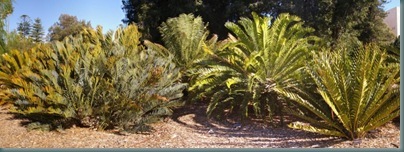
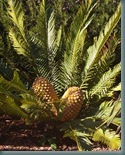

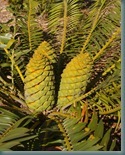
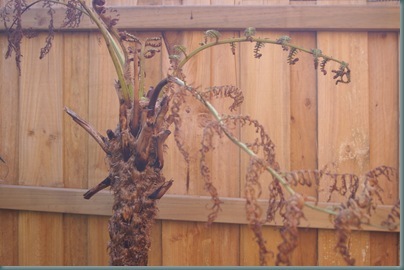




![Wollemi Pine [Wollemia nobilius] website](http://photos1.blogger.com/x/blogger2/1930/3564/240/362820/gse_multipart1061.jpg)

